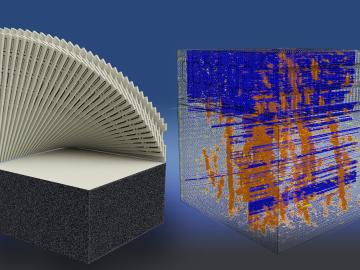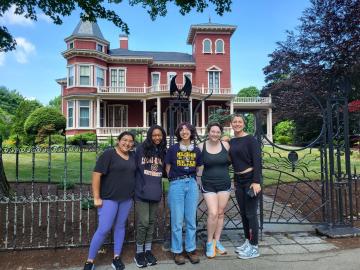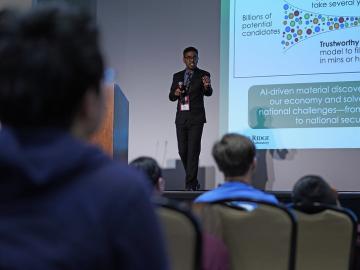
Filter News
Area of Research
News Type
News Topics
- (-) 3-D Printing/Advanced Manufacturing (29)
- (-) Artificial Intelligence (42)
- (-) Bioenergy (15)
- (-) Cybersecurity (3)
- (-) Security (12)
- (-) Transportation (10)
- Advanced Reactors (5)
- Big Data (21)
- Biology (18)
- Biomedical (16)
- Biotechnology (9)
- Buildings (21)
- Chemical Sciences (24)
- Clean Water (2)
- Composites (11)
- Computer Science (51)
- Critical Materials (8)
- Education (2)
- Emergency (2)
- Energy Storage (11)
- Environment (28)
- Exascale Computing (26)
- Fossil Energy (3)
- Frontier (21)
- Fusion (12)
- Grid (15)
- High-Performance Computing (41)
- Hydropower (1)
- Isotopes (21)
- ITER (1)
- Machine Learning (16)
- Materials (19)
- Materials Science (24)
- Mathematics (4)
- Mercury (1)
- Microelectronics (2)
- Microscopy (5)
- Molten Salt (2)
- Nanotechnology (4)
- National Security (31)
- Neutron Science (25)
- Nuclear Energy (17)
- Partnerships (29)
- Physics (13)
- Polymers (4)
- Quantum Computing (19)
- Quantum Science (24)
- Simulation (18)
- Space Exploration (4)
- Statistics (3)
- Summit (15)
Media Contacts

Researchers at the Department of Energy’s Oak Ridge National Laboratory and partner institutions have launched a project to develop an innovative suite of tools that will employ machine learning algorithms for more effective cybersecurity analysis of the U.S. power grid.

Brittany Rodriguez never imagined she would pursue a science career at a Department of Energy national laboratory. However, after some encouraging words from her mother, input from key mentors at the University of Texas Rio Grande Valley, or UTRGV, and a lot of hard work, Rodriguez landed at DOE’s Manufacturing Demonstration Facility, or MDF, at Oak Ridge National Laboratory.
The contract will be awarded to develop the newest high-performance computing system at the Oak Ridge Leadership Computing Facility.

The Department of Energy’s Oak Ridge National Laboratory has publicly released a new set of additive manufacturing data that industry and researchers can use to evaluate and improve the quality of 3D-printed components. The breadth of the datasets can significantly boost efforts to verify the quality of additively manufactured parts using only information gathered during printing, without requiring expensive and time-consuming post-production analysis.

Participants in the SM2ART Research Experience for Undergraduates program got the chance to see what life is like in a research setting. REU participant Brianna Greer studied banana fibers as a reinforcing material in making lightweight parts for cars and bicycles.

Advanced materials research to enable energy-efficient, cost-competitive and environmentally friendly technologies for the United States and Japan is the goal of a memorandum of understanding, or MOU, between the Department of Energy’s Oak Ridge National Laboratory and Japan’s National Institute of Materials Science.

Researchers at ORNL have developed the first additive manufacturing slicing computer application to simultaneously speed and simplify digital conversion of accurate, large-format three-dimensional parts in a factory production setting.

Researchers at ORNL have successfully demonstrated the first 270-kW wireless power transfer to a light-duty electric vehicle. The demonstration used a Porsche Taycan and was conducted in collaboration with Volkswagen Group of America using the ORNL-developed polyphase wireless charging system.

Prasanna Balaprakash, a national leader in artificial intelligence, or AI, spoke to some of the highest achieving students in the country at the National Science Bowl in Washington D.C.

When Oak Ridge National Laboratory's science mission takes staff off-campus, the lab’s safety principles follow. That’s true even in the high mountain passes of Washington and Oregon, where ORNL scientists are tracking a tree species — and where wildfires have become more frequent and widespread.


